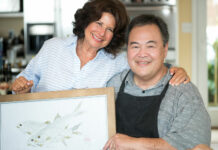Story by Diane Haynes
 And here,” Silvano says proudly, “is my personal collection.” Our host gestures toward an impressive stack of dusty wine bottles, each given to him at a special time in his life: high-school graduation, his wedding, the birth of a child, his first harvest.
And here,” Silvano says proudly, “is my personal collection.” Our host gestures toward an impressive stack of dusty wine bottles, each given to him at a special time in his life: high-school graduation, his wedding, the birth of a child, his first harvest.
“By the time you are ninety, which bottles do you hope to have opened?” I ask. “None,” he answers, a bit affronted. “I hope I will have added many more.” My husband subtly nudges me to silence. “The bottles are his scrapbook,” he whispers. A fellow farmer, Jamie understands completely. Wine is Silvano’s life.
We are in Italy, at the hilltop farm of Silvano and Rita Salvi, under a hot Tuscan sun. In every direction, as far as one can see, corduroy rows of grapevines, olive trees, rosemary and lavender fields cover rolling hills dotted with the occasional castle. Taking a break from Rita’s incredible cooking class, we follow Silvano on a private tour of the seventy-two-acre farm. Here the couple produces private-label wine, olive oil, balsamic vinegar (some aged more than thirty years), and real truffle oil—made with the treasured bounty that’s hunted and harvested from the adjoining forestlands. “Very dangerous,” Silvano warns us. “Once I had to stay in a tree for more than three hours to escape from an angry sow.”
Jamie and I are a captivated audience. We linger a few more minutes in the shade of a beautifully gnarled olive tree, one that Silvano tells us “is more than 550 years old, and still producing.” The golden-green oil Rita pours into our recipes today is infused with the history of this land and all that it has survived for millennia. “If only the tree could talk,” I muse. “Oh,” Silvano responds with a knowing look, “the land talks; you just have to listen.”
His words turn my thoughts to Maui, and to Hawaiian friends who have told me much the same thing. In fact, in this, our kama‘aina issue, we’ll pay close attention to the land, following archaeologists as they uncover the sacred island of Moku‘ula, and with it, stories of kings and queens, star-crossed lovers, and a legendary mo‘o, an enchanted lizard that once guarded the island. We have stories, too.
The Hawaiian word kama‘aina would translate easily for folks like Silvano and Rita. At its most literal, kama‘aina means “child of the land.” And yet, as Tom Stevens reveals in his linguistic exploration, it has less to do with the happy accident of one’s genealogy or geography, than with one’s relationship to the land—with having reverence and caring for that which sustains us.
Sustenance. For now, it inhabits a Tuscan kitchen. “Belissima!” Rita exclaims as I roll and cut my first pasta ever. I’m covered in flour and grinning like a school kid who just won the spelling bee. On Rita’s nod of approval, I raise my chef’s knife in triumph, proudly displaying long ribbons of fresh tagliatelle. Steam rises from every pot on the stove as Jamie drops potato gnocchi into one and Rita quickly stirs corn flour into another for polenta. A third pan sizzles with onion, garlic, and Toscana sausage married with the distinctive scents of rosemary and thyme. Home “tinned” tomatoes from last summer’s crop stand by to be added to the aromatic mixture. The heat is unbearable. I couldn’t be happier.
Later, gathered at the table with our hosts, I realize how little geography matters. It’s not where you find your feet; it’s where you find your heart. Amid these kindred spirits, with their deep and evident love for the land and their joy in sharing its bounty, we feel at home. As we raise our glasses, I can think of only one fitting toast, “To life!”
And to the kama‘aina in all of us.




